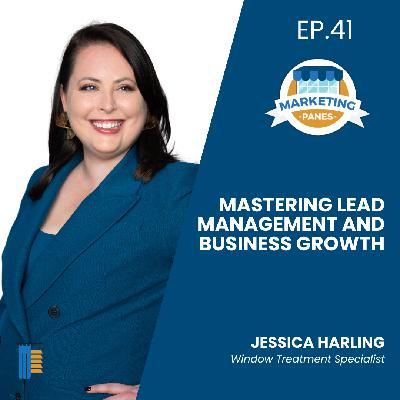A Trade Built on Thread: Susan Woodcock on Training Future Custom Fabricators
Description
Guest Profile: Susan Woodcock
Susan Woodcock is an entrepreneur, educator, and one of the most recognizable voices in the custom window treatment world. She owns Home Dec Gal, a to-the-trade workroom, and is the founder of Workroom Tech—the only trade school in the U.S. dedicated to custom home decor sewing professionals. She and her husband also produce the Custom Workroom Conference, an annual gathering that draws passionate small business owners from across the country. Today, we’re diving into her journey, what it takes to train the next generation of fabricators, and why education is more important than ever in our trade.
The Journey Into Custom Workrooms
Susan Woodcock’s path into the window treatment industry began in her mother’s drapery workroom and quickly grew into her own business in the late 1980s. From English drapery styles to modern fabrications, she developed her skills through real projects and long-term relationships with designers. Today, Susan is recognized as one of the most influential voices in custom fabrication and education.
Why Education Matters
Hands-On Training vs. Online Learning
While online tutorials are convenient, Susan emphasizes that hands-on experience is irreplaceable. Fabrics require physical interaction—draping, measuring, and managing large cuts—that can’t be fully captured in a video. That’s why her school, Workroom Tech, offers small in-person classes with direct mentorship, complemented by interactive online sessions that expand access worldwide.
Training the Next Generation
Workroom Tech attracts students from all walks of life—young parents seeking flexible careers, professionals transitioning from healthcare or law enforcement, and retirees looking for creative encore careers. What unites them is a shared passion for fabric and craftsmanship.
Starting and Growing a Successful Workroom
Tools That Matter Most
According to Susan, the most important investment isn’t a machine—it’s a professional work table. Large-scale projects like draperies and Roman shades require space to spread fabric, cut precisely, and assemble with ease. With a table and basic sewing tools, many successful businesses have started from home-based setups.
Building Value Through Craftsmanship
Susan encourages fabricators to highlight the handcrafted, custom nature of their work rather than competing on price. High-quality window treatments last decades, and clients—whether affluent or budget-conscious—value the uniqueness and durability of custom pieces.
Branding and Marketing That Work
Establishing a Presence
Susan credits much of her growth to building websites early on, which helped past clients reconnect. Social media, particularly Instagram and Facebook, has since amplified her reach, giving her a direct way to showcase projects and connect with future students.
Consistent Branding
For Susan, branding is about more than visuals—it’s about consistency. She avoids discounts to reinforce the value of craftsmanship, teaching students to maintain pricing integrity. Her strategy is simple: quality, authenticity, and confidence in the value of custom work.
The Role of Conferences and Community
The Custom Workroom Conference
Beyond the classroom, Susan co-produces the Custom Workroom Conference, an annual gathering that combines education, networking, and community. Attendees gain exposure to new methods, connect with peers facing similar challenges, and build relationships with suppliers and mentors.
The conference is known for its welcoming atmosphere—something many small business owners in this niche industry deeply appreciate. It’s less like a trade show and more like a family reunion for fabricators.
Conclusion
Susan Woodcock’s journey shows that the custom window treatment industry thrives on a balance of education, craftsmanship, and community. From equipping new fabricators with essential skills to fostering collaboration through events, her work highlights the importance of building a trade on both tradition and innovation.
Show Notes
- Guest: Susan Woodcock – Founder of Workroom Tech, Home Dec Gal, and co-producer of the Custom Workroom Conference.
- Topics: hands-on education, starting a workroom, branding and marketing, and the role of community events.
Learn more about the Custom Workroom Conference: customworkroomconference.com
Other Notes/Links:
pssst…. want to be a guest on the show?
Home Dec Gal: Visit Website
Workroom Tech: Visit Website
Video
https://youtu.be/r3whm90EDpY
Click here to display Transcript
<svg viewBox="0 0 448 512" xmlns="http://www.w3.org/2000/svg"><path d="M416 208H32c-17.67 0-32 14.33-32 32v32c0 17.67 14.33 32 32 32h384c17.67 0 32-14.33 32-32v-32c0-17.67-14.33-32-32-32z"></path></svg>
<svg viewBox="0 0 448 512" xmlns="http://www.w3.org/2000/svg"><path d="M416 208H272V64c0-17.67-14.33-32-32-32h-32c-17.67 0-32 14.33-32 32v144H32c-17.67 0-32 14.33-32 32v32c0 17.67 14.33 32 32 32h144v144c0 17.67 14.33 32 32 32h32c17.67 0 32-14.33 32-32V304h144c17.67 0 32-14.33 32-32v-32c0-17.67-14.33-32-32-32z"></path></svg>
TRANSCRIPT
Will Hanke (00:00 )
Hey everyone, welcome to another episode of Marketing Panes, the podcast where we talk with real window treatment and awning service providers or business owners about their successes and struggles related to marketing their business. I’m your host, Will Hanke. Today we’re joined with Susan Woodcock, entrepreneur, educator, and founder of Workroom Tech. the only trade school in the U.S. for custom home decor sewing pros. She also runs Home Dec Gal and produces the custom workroom conference, fabricators together from all over the country. In this episode, we’ll talk about her journey, the importance of hands-on education, and how workrooms can thrive in today’s industry.
Susan Woodcock is an entrepreneur, educator, and one of the most recognizable voices in the custom window treatment world. She owns Home Dec Gal, a to-the-trade workroom, and is the founder of Workroom Tech, the only trade school in the US dedicated to custom home decor sewing professionals. She and her husband also produced the Custom Workroom Conference, an annual gathering that draws passionate small business owners from across the country. Today we’re diving into her journey
what it takes to train the next generation of fabricators and why education is more important than ever to our trade. Susan, thank you so much for being on the show.
Susan Woodcock (01:24 )
Hello, Will, thank you so much. It’s a pleasure to be here with you today.
Will Hanke (01:27 )
Thank you. So let’s jump in and talk about custom work rooms. What exactly are they? And tell us a little bit about the story of how you got into this side of the industry.
Susan Woodcock (01:39 )
Okay, well a custom workroom is ⁓ usually a small business. There’s also some larger commercial workrooms that do custom work, but works directly with interior design trade to create those beautiful window treatments and custom upholstered pieces. And then some workrooms work retail and work directly with customers, helping them with their interior design. So it’s an industry full of people that work with their hands and are actually making things in their businesses.
Will Hanke (02:14 )
I like that. So before focusing on the fabrication and teaching students how to sew, did you do any other types of sewing like for a different industry that moved you towards this?
Susan Woodcock (02:28 )
No. I think I’ve made one dress in my life, no garment sewing, dabbled in quilting a little bit. My mother had a drapery workroom in her home, and that’s how I learned. And then I started my own drapery workroom. When I left college, I was an art major, fine arts. And ⁓ there were so many jobs for fine art majors out there, right?
Will Hanke (02:30 )
Okay.
I bet. ⁓
Susan Woodcock (02:56 )
So I started a drapery workroom in 1988 and been doing it ever since.
Will Hanke (03:04 )
wow. What do you guys focus on mostly in the workroom?
Susan Woodcock (03:08 )
draperies, round shades, slip covers, that sort of thing.
Will Hanke (03:13 )
Okay, okay.
What did the early days of getting started out of college, what did that look like?
Susan Woodcock (03:19 )
Well, I started out with one designer and she was very busy and very successful and she really directed the style of my work. So she did English drapery method which is bump interlining and ⁓ back then in the late 80s it was chintz fabrics and silks and valances and trims and ⁓ a lot of things that we’re seeing come back now which is exciting.
But it really gave me an opportunity to learn on the
























